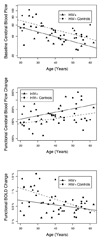HIV infection and aging independently affect brain function as measured by functional magnetic resonance imaging
- PMID: 20047503
- PMCID: PMC2804778
- DOI: 10.1086/649899
HIV infection and aging independently affect brain function as measured by functional magnetic resonance imaging
Abstract
We investigated the interactions between human immunodeficiency virus (HIV) infection and aging and their effects on brain function demands by means of functional magnetic resonance imaging (fMRI). A multiple-regression model was used to study the association and interaction between fMRI measures, HIV serostatus, and age for 26 HIV-infected subjects and 25 seronegative subjects. Although HIV serostatus and age independently affected fMRI measures, no interaction occurred. Functional brain demands in HIV-positive subjects were equivalent to those of HIV-negative subjects who were 15-20 years older. Frailty parallels between HIV infection and aging could result from continued immunological challenges depleting resources and triggering increased metabolic demands. In the future, fMRI could be a noninvasive biomarker to assess HIV infection in the brain.
Conflict of interest statement
Beau M. Ances- no conflict of interest
Florin Vaida – no conflict of interest
Melinda J. Yeh- no conflict of interest
Christine L. Liang- no conflict of interest
Richard B. Buxton- no conflict of interest
Scott Letendre- no conflict of interest
J. Allen McCutchan - no conflict of interest
Ronald J. Ellis- no conflict of interest
Figures

References
-
- Fried LP, Tangen CM, Walston J, et al. Frailty in older adults: evidence for a phenotype. J Gerontol A Biol Sci Med Sci. 2001;56:M146–M156. - PubMed
-
- Buxton RB, Uludag K, Dubowitz DJ, Liu TT. Modeling the hemodynamic response to brain activation. Neuroimage. 2004;23 Suppl 1:S220–S233. - PubMed
-
- Chang L, Tomasi D, Yakupov R, et al. Adaptation of the attention network in human immunodeficiency virus brain injury. Ann Neurol. 2004;56:259–272. - PubMed
-
- Wong EC, Buxton RB, Frank LR. Quantitative imaging of perfusion using a single subtraction (QUIPSS and QUIPSS II) Magnetic Resonance in Medicine. 1998;39:702–708. - PubMed
Publication types
MeSH terms
Grants and funding
- R01 AI057167/AI/NIAID NIH HHS/United States
- NS-36722/NS/NINDS NIH HHS/United States
- R01 AI047745/AI/NIAID NIH HHS/United States
- U01 AI027670/AI/NIAID NIH HHS/United States
- R21 AI047745/AI/NIAID NIH HHS/United States
- AI29164/AI/NIAID NIH HHS/United States
- K23 MH081786/MH/NIMH NIH HHS/United States
- AI47033/AI/NIAID NIH HHS/United States
- P30 AI036214/AI/NIAID NIH HHS/United States
- N01 MH022005/MH/NIMH NIH HHS/United States
- AI57167/AI/NIAID NIH HHS/United States
- AI47745/AI/NIAID NIH HHS/United States
- R01 NS036722/NS/NINDS NIH HHS/United States
- 1K23MH081786/MH/NIMH NIH HHS/United States
- P30 MH62512/MH/NIMH NIH HHS/United States
- AI36214/AI/NIAID NIH HHS/United States
- R01 NS042069/NS/NINDS NIH HHS/United States
- R37 AI029164/AI/NIAID NIH HHS/United States
- AI27670/AI/NIAID NIH HHS/United States
- K23 AI055276/AI/NIAID NIH HHS/United States
- AI55276/AI/NIAID NIH HHS/United States
- U01 AI043638/AI/NIAID NIH HHS/United States
- R56 AI047745/AI/NIAID NIH HHS/United States
- R01 NR012657/NR/NINR NIH HHS/United States
- P30 MH062512/MH/NIMH NIH HHS/United States
- UL1 TR000448/TR/NCATS NIH HHS/United States
- NS-42069/NS/NINDS NIH HHS/United States
- MH62512/MH/NIMH NIH HHS/United States
- AI43638/AI/NIAID NIH HHS/United States
- R01 AI047033/AI/NIAID NIH HHS/United States
LinkOut - more resources
Full Text Sources
Medical

